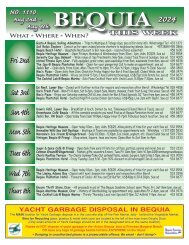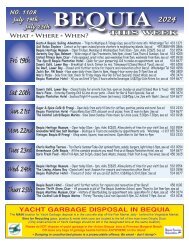Caribbean Compass Yachting Magazine - December 2020
Welcome to Caribbean Compass, the most widely-read boating publication in the Caribbean! THE MOST NEWS YOU CAN USE - feature articles on cruising destinations, regattas, environment, events...
Welcome to Caribbean Compass, the most widely-read boating publication in the Caribbean! THE MOST NEWS YOU CAN USE - feature articles on cruising destinations, regattas, environment, events...
Create successful ePaper yourself
Turn your PDF publications into a flip-book with our unique Google optimized e-Paper software.
— Continued from previous page<br />
Monday, January 4th<br />
The first peak meteor shower of 2021 is the Quadrantids. Earth actually started<br />
passing through a comet’s debris field towards the end of <strong>December</strong>. The best days<br />
to spot some meteors are <strong>December</strong> 28th through 31st because there will be less<br />
inference from moonlight. The meteor shower occurs just before dawn offering up 60<br />
to 200 meteors per hour. The best time to look for the shower is between 0300 and<br />
0530 hours. The meteors will radiate out of the northeastern sky but can appear<br />
anywhere in the sky.<br />
JIM ULIK<br />
NASA (1965)<br />
Above: Moon and planets at dusk<br />
Left: Gemini VII during ‘Jingle Bell’ rendezvous with Gemini VI.<br />
Below: Some major landmarks on the last quarter Moon at 0500 on January 6th<br />
Wednesday, January 6th<br />
The Moon rises after midnight, reaching third quarter right before dawn. A few degrees<br />
towards the southeast is the blue-white star Spica. Arcturus is the bright star towards<br />
the north. Venus is rising after 0500. Three major Moon landmarks at last quarter are<br />
the Sea of Rains, Ocean of Storms and the Sea of Clouds (see image at right).<br />
Friday, January 8th<br />
The minor meteor shower Rho Geminids will be visible for over a month. The<br />
shooting stars you spot radiating out of the constellation Gemini may be few, but<br />
they will be traveling very fast across the night sky. For future reference, slow<br />
meteors are red or orange while fast meteors frequently have a blue color.<br />
Saturday through Wednesday, January 9th through 13th<br />
Low in the western sky, Mercury, Jupiter and Saturn jockey for position over the<br />
next few days as they sink below the horizon at dusk. At 0100 on January 13th the<br />
Moon reaches its New Moon phase. Over the next 18 hours it will gradually move<br />
away from the Sun, taking its position with Mercury, Jupiter and Saturn.<br />
In the News<br />
Electric engines are continuing to make a presence into the marine market. One<br />
company has sold over 100,000 electric marine engines with models that can power<br />
yachts up to 120 feet long. Future NASA spinoff technologies can benefit from this<br />
innovation with advances in charging systems. In 2121, a company will launch solar<br />
cells constructed with different chemical combinations designed by a team of<br />
investigators at NASA’s Glenn Research Center. The spacecraft destination is Lacus<br />
Mortis (see image at right). These cells will be tested for power efficiency, life span<br />
and heat and radiation tolerance for space. The advanced technology will improve<br />
Earth based solar cells.<br />
All times are given as Atlantic Standard Time (AST) unless otherwise noted. The<br />
times are based on a viewing position in Grenada and may vary by only a few minutes<br />
in different <strong>Caribbean</strong> locations.<br />
Jim Ulik sails on S/V Merengue.<br />
DECEMBER <strong>2020</strong> CARIBBEAN COMPASS PAGE 29<br />
VIP service to discover the<br />
best of Grenada's art.<br />
Private tours of galleries & studios.<br />
Book online at arthouse473.com<br />
Susan Mains<br />
Asher Mains

















